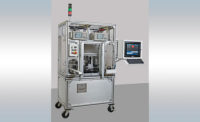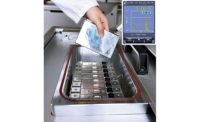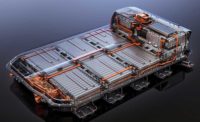Myriad automotive components are checked for leaks, including turbochargers, oil filters and radiators. However, leak testing doesn’t end with the suppliers of those components. After final assembly, automotive OEMs are apt to leak-test air-conditioning systems, fuel lines, battery packs and other subassemblies in situ as one final check of quality.
Such testing is typically done with a handheld sniffer probe positioned at various connection points. While that may sound simple, the process is a little more complicated than one might imagine. For consistent and accurate results, the probe must be held at a specific distance from the part, for a specific period of time, and, in some cases, moved along the part at a specific speed.
Even the best-trained, most experienced operators will be unable to do that consistently for a full shift. That’s why OEMs are increasingly turning to six-axis robots to handle the job.
“Coupling leak testing with robotics solves a number of production issues,” says Thomas Parker, North American automotive sales manager for Inficon. “Known problem areas, such as high-pressure fuel-line connections, electric vehicle batteries and air-conditioning systems, can be tested with a high level of confidence with robotic systems.”
There are two types of robotic leak detection methods: stationary and dynamic. Stationary testing employs a robotic arm equipped with a sniffer probe that moves to preselected points on the test part, then remains stationary for a defined period of time. These “dwell” times are based on potential leak rates at each point.
For dynamic tests, a robotic arm moves the probe in a continuous path along a test part’s surface. The accuracy of a dynamic test is based on the distance maintained between the part and the sniffer probe, the speed at which the robotic arm travels, and how much air and test gas the leak detector is able to sniff.
Dynamic tests can quickly check relatively large component areas, while maintaining permissible cycle times.
Small leaks involving critical components, such as electric vehicle batteries, only release very small amounts of test gas, which makes leak detection even more challenging. To solve the problem, Inficon has developed a new leak-detection system capable of locating small leaks at much faster rates than conventional systems.
Inficon’s new XL3000flex is designed to sniff extremely small leaks up to 20 times faster than most current systems. For example, the instrument can detect leaks at sample flows of 300 or 3,000 standard cubic centimeters per minute (sccm), making it ideal for robotic sniffing. Most conventional sniffers are only capable of sniffing at 60 to 150 sccm, which is too slow to meet typical production cycle-time requirements.
At a leak rate of 10-3 millibar-liter per second (mbar l/s), the instrument can detect a leak with 100 percent reliability at a sniffer probe speed of up to 14 centimeters per second. Above that speed, detection probability slowly decreases. At a detection rate of 10-4 mbar l/s (appropriate for liquid fuel leaks) and a probe distance of 6 millimeters, the XL3000flex shows nearly 100 percent reliable results at speeds below approximately 8 centimeters per second.
Robotic leak testing is one of many new technologies that have been introduced recently to address application challenges in the automotive, medical and appliance industries. The following are some other notable, new leak testing products.
Multichannel Leak Tester
The Hydra from ATEQ Corp. is a multichannel leak tester that allows engineers to remove one channel for service or calibration and continue to test with the remaining channels. The device allows simultaneous or sequential pressure decay leak testing on four completely independent channels. Each channel has its own leak test transducer, and each leak test channel has less than 1.5 cc of internal volume. Engineers can test in pressure and vacuum on the same instrument.
The instrument has a color touch screen with WinAteq 300 software, which includes statistical process control, data collection and various real-time leak test results displays. It includes four RS-232 ports, two USB ports, an Ethernet port, and four discrete I/O cards. Pass-fail indicator lights are located over each test port, and a variety of front test port fittings are available.
Pressure Decay and Mass Flow
The Sentinel I28 from Cincinnati Test Systems is a single-station air flow and leak detection system. It is equipped with a valve manifold that has been tested for more than 40 million cycles. This manifold is paired with a new high-performance pressure transducer that reduces test cycle times and improves accuracy and repeatability. A high-contrast, 24-bit color display provides X-Y graphing for pressure, loss or flow.
The instrument is configurable for a variety of pressure decay testing or mass flow testing requirements. It stores up to 99 preprogrammed test sequences, and features a “parent program” that holds a customized test sequence for multi-test applications.
The test program can be selected via keypad, RS-232 or binary switch. Test result evaluation is user-selectable, and the output format for test results can be configured to meet specific needs.
The instrument is designed for easy operator setup and troubleshooting. It has a small footprint (12 by 9.25 by 8.75 inches) for easy installation in limited space, including wall mounting.
The device can interface with a bar code reader, and expanded instrument control is possible through Ethernet/IP communication.
Leak Tester for Medical Devices
The SprintMD leak tester from Uson LP is designed to help medical device manufacturers meet regulatory compliance and product performance requirements.
The instrument can perform a variety of tests, including pressure decay; sealed component; volume verification; inter-lumen decay; vacuum decay; occlusion; back-pressure; seal creep; burst; crack; and fast flush.
An 8.5-inch color touch screen LCD provides a dashboard-style user interface. An intuitive menu system offers access to a range of data and reports. The system can display statistics such as pass, fail, minimum, maximum and standard deviations. Analytics track historical trends and identify process degradation before it can adversely affect throughput. Self-diagnostics provide information about the health of the tester.
Fast cycle times and simple programming help maximize throughput and accommodate complex testing requirements. The instrument also incorporates embedded fieldbus
technology and expanded digital I/O to optimize control and selection of programs. With the SprintMD, it’s possible to achieve two-way communication to send start and stop commands, select program commands, and communicate testing, accept or reject status, as well as data from each step of the process.
Performance and repeatability are achieved through a redesigned block manifold and low-wattage valves that minimize the chance of leaks, improve field-time repeatability and sensitivity, and reduce dead volume.
High-Resolution Leak Tester
The TME Solution from TM Electronics can perform a variety of leak and flow tests, including burst, occlusion, vacuum decay, pressure decay, crack, differential pressure, and differential vacuum. The device offers a resolution of 0.0001 psi per second.
The device can be equipped with up to four ports, and dual switching is available to maximize productivity. The touch screen menu system allows easy input and storage of 100 linkable programs, with data storage for 5,000 test results. Real-time statistical analysis and quality control charts are accessible on demand.
A two-way RS-232 computer connection is standard for data collection and remote parameter control, but Ethernet connectivity is available to allow data to be transmitted from the instrument to a LAN.
The instrument provides CFR Part 11 data protection and conforms to ASTM and ISO-11607 guidelines. Calibration is NIST traceable.
Optional accessories include:
- Restraining plate fixtures for leak testing pouches with semiporous surfaces to stabilize expansion during pressurization without blocking any holes in the surface material.
- Filter assemblies that remove water, oil and particulate matter from pressurizing air.
- Pneumatically operated clamps that provide either a sealed leak-tight access to a tubular product or a sealed leak-tight dead end to the product during pressure decay leak testing.
Device Tests EV Batteries
The HeTech from Marposs Corp. is a helium-based leak tester for battery systems used in electric vehicles. The instrument detects leaks in cooling tubes, hoses and plates; prismatic battery cells and modules; and battery pack assemblies.
To begin the test, the part is placed into a chamber where a vacuum is created. The part is then pressurized with helium, and any leakage is measured with a mass spectrometer. The system features two vacuum chambers with manual opening and closing. The chambers alternate so that while one chamber is closed and running the test cycle, the other chamber is open for loading and unloading.
The system is designed to inspect complete cells prior to being filled with electrolyte and sealed. It can detect leaks ranging from 5 x 10-3 to 5 x 10-8 mbar l/s.
The system has a touch-screen color monitor with two remote control boxes featuring push buttons and light sensors for the operators. The system has separate outlet ports for helium and air discharge, and it can be connected to a helium recovery system.









